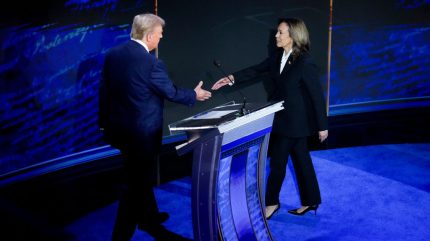
The direction of foreign direct investment (FDI) policy would be “fairly similar” under Kamala Harris or Donald Trump because of a focus on domestic production, according to macroeconomic forecasting consultancy TS Lombard’s chief US economist Steven Blitz.
There are general tendencies that would remain the same: competition against China, the rise of reshoring/nearshoring and a focus on domestic manufacturing, as outlined by GlobalData’s US Elections 2024 Executive Briefing.
However, while both candidates would try to redirect outward FDI back into the country, they would do so through different policy decisions.
Trump: tariffs, tariffs and more tariffs
Trump’s famous favourite word is also central to his plan to grow manufacturing in the US. He has suggested a 60% tariff on all imports from China and a 20% tariff on all imports from other countries. He claims that high import tariffs will incentivise companies that want market access to the US to set up manufacturing plants in the country and employ local workers.
“You can believe the fairy tale if you want,” says Blitz on the linear logic that purportedly would lead to a surge in FDI. He explains that the plan assumes that there would be “no reaction from the other side”. While it could bring in investment for some industries, he emphasised that “historic data shows that tariffs are a terrible way”. Many economists have expressed worries that consumers would carry the burden of that tax.
In an interview with Trump, Bloomberg editor in chief John Micklethwait highlighted that this process of reshoring would take “many, many years”. Micklethwait added this would increase prices for consumers while Trump rebutted that it wouldn’t happen “because countries will pay”.
Blitz says that Trump may be banking on the asymmetrical relationship that the US has with the rest of the world. The US is a critical global market, and foreign companies are “much more dependent on selling [their] product” in the US than vice versa.
“The world depends on US growth, but the US does not depend on global growth,” he added.
Even if foreign companies do deploy resources to set up production in the US, as Micklethwait said it would take many years and, in the meantime, the US consumer would feel the costs.
During his first presidency, Trump lowered corporate income tax from 35% to 21%. Gary Hufbauer, a senior fellow at the Peterson Institute for International Economics said the “tax cuts on the whole were favourable, and I would expect that if he had stopped there, we would have had more inward investment”. If he wins, Trump is promising to lower that tax rate even more to 15%. Harris plans to raise it to 28%.
Trump also wants to slash the green policies implemented by the Biden-Harris administration and revamp the production of oil, gas and coal. He has said he would “rescind all unspent funds” of the Inflation Reduction Act (IRA), a consequential climate policy passed in 2022.
Harris: continuity with a home bias
Harris also wants to increase domestic production, keep US investments within its borders and attract foreign capital. She is likely to offer policy continuity from the Biden administration, which passed two major policies to spur green and technology investments in the US.
The CHIPS and Science Act, passed in 2022, offered billions of dollars to boost the US’ domestic semiconductor capacity. Since 2019, there has been $100bn in FDI for the semiconductor industry driven by the policy, according to GlobalData’s Thematic Intelligence Report. The policies came at the same time as the US took more formal steps to curb Chinese production of semiconductors, a policy that has continued, with allies like Japan and the Netherlands aligning with the US’ position.
The Center for Strategic and International Studies points out that the Biden-Harris administration must strike a balance between bolstering domestic production and curbing exports since these “can also adversely affect the user”.
The IRA offered incentives for green investments. Harris hopes to continue to use the IRA to grow the green technology industry, although fossil fuel production still boomed under the Biden-Harris administration. She has reversed her stance on fracking, which in 2020 she said should be banned.
She now says that oil and gas production are beneficial to the green energy transition because they will keep consumer prices low, as the country invests in a shift to lower-emissions energy sources. It is a policy shift that has caused major backlash from the progressive wing of the Democratic party.
Trump says he would rescind all unspent funds of the IRA.
Between January 2021 and August 2024, the Biden-Harris administration has attracted $583bn in announced greenfield FDI capex, according to fDi Markets estimates. That is a 76.7% increase from the $329.96bn worth of FDI that was pledged during Trump’s presidency, from January 2017 to December 2020.
Conclusion
Blitz reiterated that the thrust of both candidates’ policies is to redirect outward investments inward. “Either Harris or Trump would not be favourably disposed to firms investing globally, because they are trying to create more production in the US,” he said.
Which plan will set that process in motion will be up to the voters to decide.



